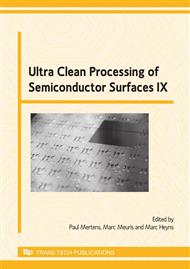p.353
p.357
p.363
p.367
p.371
p.377
p.381
p.385
p.389
Process Dependence on Defectivity Count on Copper and Dielectric Surfaces in Post-Copper CMP Cleaning
Abstract:
At critical dimensions of 65nm and lower, the tolerances for yield impacting “killer” particle defects become ever tighter and this is especially true for Cu PCMP cleaning. This is a critical step in reducing wafer defectivity and metal contamination directly impacting yield and reliability. A successful candidate must exhibit a number of additional attributes not least of which are compatibility to Cu while selectively removing copper oxides (CuOx), and be fully compatible with porous ULK and barrier materials. Conventionally PCMP cleans typically require two different acidic or alkaline solutions containing a surfactant to drive particle removal and surface metal preparation; however this is not without its limitations e.g. crack propagation, water absorption, low-k wetting, water marks and galvanic corrosion. It would be advantageous if Cu PCMP could be performed with a single neutral pH cleaning solution. The paper will present results of work conducted on a neutral, single step Cu Post CMP (PCMP) cleaning solution, EKC PCMP5510™, and will discuss the influences of different process parameters in optimising defect removal from Cu and Ultra Low-K (ULK) dielectric surfaces (K=2.5) thus highlighting the fundamental differences in cleaning either surface.
Info:
Periodical:
Pages:
385-388
Citation:
Online since:
January 2009
Authors:
Keywords:
Price:
Сopyright:
© 2009 Trans Tech Publications Ltd. All Rights Reserved
Share:
Citation:


